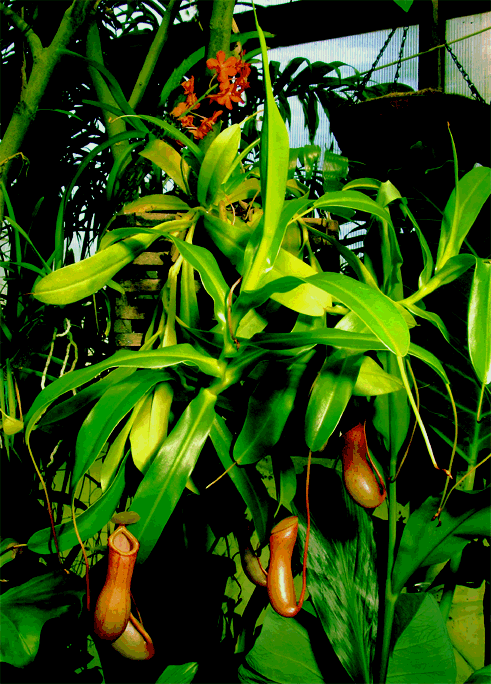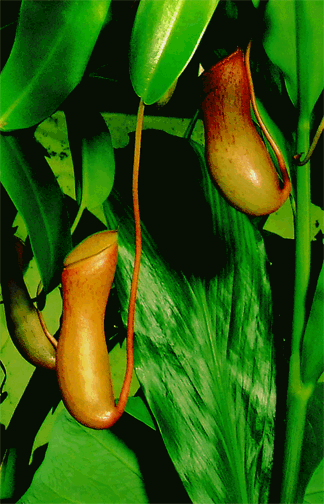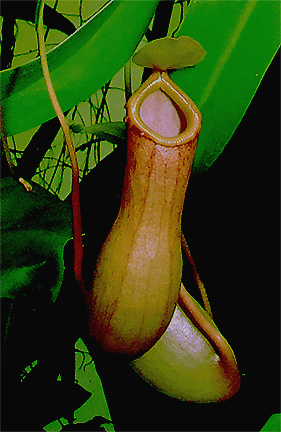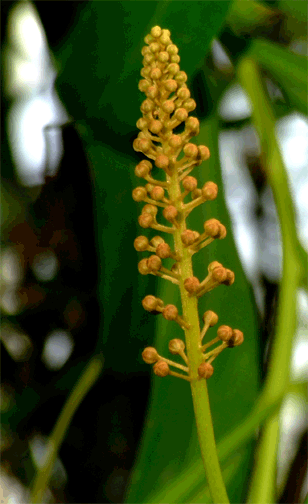![]()
Aroids and other genera in the Collection
Take the Tour Now?
Orchids
The
Exotic Rainforest
Plants in
the Exotic Rainforest Collection
Images on this website are copyright protected. Contact us before
attempting to reuse.
Nepenthes ventricosa Blanco

Carnivorous "Pitcher" Plant
 In 2004 we began
to find a lot of ants in the atrium. I don't like to use bug killers
if I
can avoid them since I have a lot of rain forest animals living in the
Exotic Rainforest including tree frogs and anoles (lizards). So I
began to seek other methods of controlling the
excess ant population
including extra tree frogs and lizards. One collector I traded e-mail with suggested "pitcher"
plants with Nepenthes ventricosa the most easily found.
Originally discovered in the Philippines (native to the island of Luzon),
Nepenthes ventricosa is found in nature at an elevation of 1200 to 1500
meters (3900 to 4900 feet). The unusual rain forest epiphyte (ep-a-FIT)
or tree dwellers is
found within the genus Nepenthes are largely from Borneo and a few
additional SE Asian countries Species are found in parts
Madagascar off the east coast of Africa, in southern and SE Asia, northern
Australia, the Philippines, Borneo, the Caroline Islands of the Pacific
Ocean and one species in China. And they literally eat bugs for
breakfast!
In 2004 we began
to find a lot of ants in the atrium. I don't like to use bug killers
if I
can avoid them since I have a lot of rain forest animals living in the
Exotic Rainforest including tree frogs and anoles (lizards). So I
began to seek other methods of controlling the
excess ant population
including extra tree frogs and lizards. One collector I traded e-mail with suggested "pitcher"
plants with Nepenthes ventricosa the most easily found.
Originally discovered in the Philippines (native to the island of Luzon),
Nepenthes ventricosa is found in nature at an elevation of 1200 to 1500
meters (3900 to 4900 feet). The unusual rain forest epiphyte (ep-a-FIT)
or tree dwellers is
found within the genus Nepenthes are largely from Borneo and a few
additional SE Asian countries Species are found in parts
Madagascar off the east coast of Africa, in southern and SE Asia, northern
Australia, the Philippines, Borneo, the Caroline Islands of the Pacific
Ocean and one species in China. And they literally eat bugs for
breakfast!
Described to science in 1837, Nepenthes ventricosa is considered scientifically to be "lianas" (a hanging vine) or a shrub to 20 meters (65 feet) in length. The species grows traps from the tips of its leaves that look like "pitchers" complete with a "lid" that hang from the ends of it's leaves. The pitchers, which are a modified leaf, produce an acidic nectar soup that mixes with collected rain water. The mixture of their own pheromone (perfume) mixed with the rain produces a "soup" which produces a powerful insect attractant. Insects are drawn to the scent of the nectar soup and once they enter the pitcher they fall into the soup and are metabolized and devoured! Interestingly, the Nepenthes does not eat most ants! Through a phenomenon called myrmecophily the plant freely gives the ants it's nectar and in exchange the ants attract other more desirable insects to the pitchers! Some species of Nepenthes (not N. ventricosa) even offer a rare species of ant a home in which to nest. So the experiment to use the plants to control the ant population was of little value. Still, the plant is a wonderful addition to our rain forest environment!
Once published to science, any plant receives
not only the name assigned by the botanist who wrote the scientific
description, but their last name is also added and becomes a part of the
plant's scientific name. In the case of this species, the word
"Blanco" refers to the name of the botanical author, not any color
of the plant. I have had
individuals inquire if I grow a Nepenthes sp. with white pitchers
since "blanco" in Spanish refers to the color white. I am unaware of any
such species. According to the Royal Botanic Gardens, Kew in London and
other accredited sources there are currently 85 to 90 accepted species of
Nepenthes. Sites such as Wikipedia list more names but if a name cannot
be
 found on a scientifically accepted source technically it is not a
"species". Only when the name is accepted and published in an
accredited botanical journal does it become a scientific name.
Collectors are especially notorious at coining their own Latin sounding
names which sometimes stick with plants traded from collector to collector.
Although popular, those names have no standing in science. Lists can
be found on the internet with up to 120 "species", however if a collector is
serious about their plants, many of these names can quickly be eliminated as
simply "made-up" names.
found on a scientifically accepted source technically it is not a
"species". Only when the name is accepted and published in an
accredited botanical journal does it become a scientific name.
Collectors are especially notorious at coining their own Latin sounding
names which sometimes stick with plants traded from collector to collector.
Although popular, those names have no standing in science. Lists can
be found on the internet with up to 120 "species", however if a collector is
serious about their plants, many of these names can quickly be eliminated as
simply "made-up" names.
In habitat, Nepenthes ventricosa can be found in bright but slightly diffused light. Temperatures range from tropical highs to approximately 10 degrees Celsius (50 degrees F) as a low. Nepenthes ventricosa is a vine that is similar to plants known by botanists as "trash can" plants. In their native habitat the vine attaches to a tree, often in the crook of large limbs, and thus collects falling debris around its base. That dead debris begins to decompose and acts as a "sponge" to collect and hold water which the plant utilizes. The decomposition also serves as a source of nutrients for the plant, thus allowing the Nepenthes species to produce its own fertilizer. These species do not like rich soil and prefers a very poor potting medium. As a result, collectors have learned a compost mixture of peat and Perlite™ mixed with orchid bark works well as a potting medium. However, this "compost" should be changed annually to avoid excessive decomposition.
Despite the suggestions of some Nepenthes fanatics, we water our plants with tap water and a weak fertilizer mixed with a little liquid Vitamin B-12. The B-12 seems to help plants grow a little faster and is available commercially under a variety of brand names. Some growers prefer only rain water or distilled water. However, it does appear the more delicate species require a source of purified water similar to rain water.
 Once the pitchers of Nepenthes ventricosa age they begin to deteriorate and dry
out as can be seen near the orchid basket. Baskets are very useful for
displaying the plant since they allow the vine to hang gracefully and the
pitchers to hang freely while the water drains completely from the plant's
pot. We have several species and dozens of plants, many now small! Taking a cue
from nature, and being from the Philippines, mist the plant often and don't allow it
to dry out. Nepenthes ventricosa is truly a rain forest plant!
Keep it evenly damp all the time. Don't worry about keeping it in your
home. The plant does not attract ants or insects in the home and you don't
have to feed the plant any bugs to keep it happy!
Once the pitchers of Nepenthes ventricosa age they begin to deteriorate and dry
out as can be seen near the orchid basket. Baskets are very useful for
displaying the plant since they allow the vine to hang gracefully and the
pitchers to hang freely while the water drains completely from the plant's
pot. We have several species and dozens of plants, many now small! Taking a cue
from nature, and being from the Philippines, mist the plant often and don't allow it
to dry out. Nepenthes ventricosa is truly a rain forest plant!
Keep it evenly damp all the time. Don't worry about keeping it in your
home. The plant does not attract ants or insects in the home and you don't
have to feed the plant any bugs to keep it happy!
As can be seen from the inset photo, the species produces seed pods which also grow from the end of a leaf. The inflorescence produces both male and female flowers which, if pollinated, will produce seeds. Once the hair-like seeds ripen the seed pods turn brown and begin to split open. Gather the small seeds as quickly as possible before they are disbursed and sow them over a mixture of peat, Perlite™ and orchid bark. With a bit of luck you can easily grow a new crop of plants which will take about one year to begin to mature.
The red inflorescence at the top of the photo (top of page) is a vandacous orchid and not a part of this Nepenthes plant. Nepenthes ventricosa is an unusually wonderful house plant that will have people asking you questions. I finally gave up and just used ant traps to control the ants!
One word of explanation: the
majority of common species sold in the United States are actually tissue
cultured rather than taken from the wild. A tissue cultured specimen
is simply a cloned specimen. There are a few companies
that import more difficult to grow species. This website will give you
additional information on rare and unusual forms of the plants within the
genus Nepenthes:
http://www.BorneoExotics.com/
Information sources: Royal Botanic Gardens, Kew, London and the Missouri Botanical Garden, St. Louis.